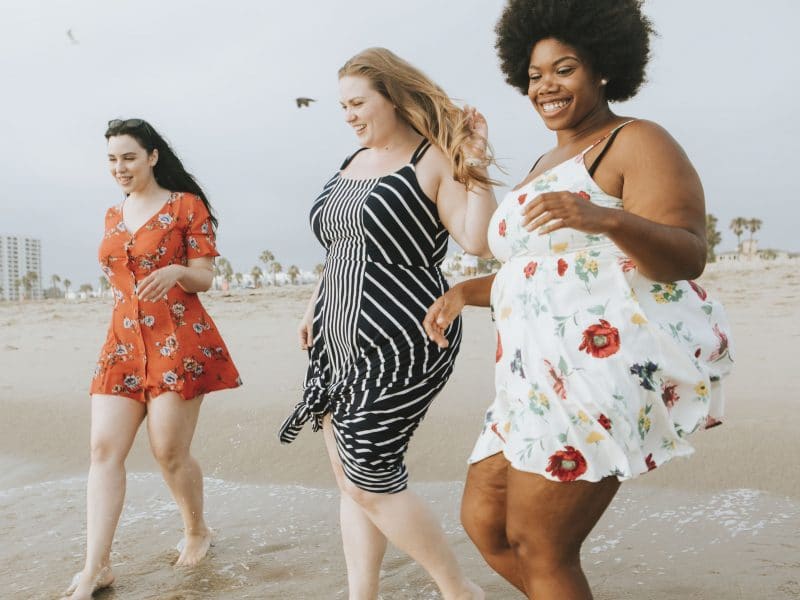For thousands of years women have used shapewear to achieve the ‘ideal’ body shape. This is indeed a tale as old as time, and every generation and era dictates a new version of perfection. Just as this perception shifts, so does the evolution of shapewear to meet demand. Indeed, the Ancient Minoans used fabric to bind their waists long before we saw the restrictive corsets of the Victorian era. While the bullet bras and girdles of the 50’s embraced the hourglass figure long before the invention of Spanx.
But how will shapewear fare in the future? Here’s what we predict is ‘in the stars’ for the world of shapewear…
Fabric and textile innovation
In decades and centuries past, a combination of art, prosperity, war and society has influenced what we view as the ‘ideal’. Likewise, politics and textile innovation has influenced shapewear itself. During the Victorian era, whalebone corsets gave way to steel, which in itself gave way to less restrictive shapewear when WW2 war broke out and steel became a valuable commodity. Necessity being the mother of invention, this lead to the advent of nylon and elastic shapewear, which ultimately bought about the invention of Spanx at the turn of the 21st century.
Shapewear currently tends to be made of a nylon and lycra. However, as both are synthetic fibres they don’t breath. This can make them uncomfortable in warmer weather. As a result, recently we’ve seen lighter versions of shapewear hit the market. These incorporate cotton and microfibre, which aid moisture absorption and odour control. In the future, we expect even greater textile innovation so the days of sweating profusely in overly restrictive synthetic material becomes a thing of the past.
Influencers dictating the ideal shape
There’s no doubt that art and fashion have a big impact on what we view as perfection. But in recent years we’ve witnessed something far more revolutionary. Yes, we’re talking the rise of celebrity and the advent of social media. The more we see a body shape, be that in TV shows, magazine shoots or on Instagram, the more we want to emulate it. Indeed, this recent move to a curvier ideal has been driven by the popularity of celebrities such as the Kardashians. Kim Kardashian has even created her own brand, Skims, to promote the ideal that is actually her own body shape.
So to keep an eye on coming trends, look at the world of celebrity and the ideal they’re toting. Right now, it’s a smaller bust, tiny waist and curvy butt, but who knows this could all change.
Shapewear not being just about slimming
As shapewear has moved from hidden support to mainstream popularity, it’s become more accepted by society as the norm. In fact, if you look at the vast range of shapewear it’s no longer just used for slimming your curves. Padded shaping shorts that actually increase the size of your butt are now incredibly popular, as are padded bras with slimming panels to boost your cleavage while minimising pesky back fat.
This shows how far shapewear has evolved – it’s actually about cinching in problem areas but promoting the curves just where you need them to be. In fact, we believe shapewear now celebrates a more bountiful figure, and this is only set to continue with each passing trend.
Shapewear for the boys!
Finally, we’re seeing more shapewear being developed for men. After all, young men in particular also face having to live up to an ‘ideal’.
Here are just some items you can expect to see more of, both on the high street and online:
- Chest firming vests
- Padded sculpting vests
- Waist slimming briefs
- Butt lifting shorts
- Lumbar support girdles
Body positivity influencing change
As plus size models take the fashion world by storm, we’re predicting more acceptance for the fuller figured ladies among us. We no longer need to achieve a perfect ‘10’, just make the most of the curves given to us. This should lead to an even greater range of sizes and styles of shapewear available in stores.
Shapewear tailored by body shape not just size
This acceptance of the fuller figure and the fact that we’re all different shapes and sizes will lead to more innovative shapewear. Shapewear that isn’t simply scaled up, but designed for each specific body shape, including:
- Hourglass – hips and shoulders the same width, ample bust and slim waist
- Rectangle – smaller bust, boxy torso, slim hips and long legs
- Apple – fuller bust and tummy, with slim shoulders and hips
- Pear – smaller bust and shoulders, defined waist, full hips and thighs
- Inverted triangle – wide shoulders and large bust, slimmer hips
So as you can see, we’re not all one shape, so why should one style fit all? Just as we see jeans in hip and leg length, with curvy and petite fits, we predict specific fits for the most popular shapewear products in the future.
Increased popularity of body shaping fabric
This is something new that won’t fully replace shapewear. Body shaping fabric is essentially tape that can be cut and placed just where you need a small amount of support. Be that under your bust for a little lift or for thigh or butt contouring, we think this will become increasingly popular in months to come.
The future’s bright for shapewear
The future is definitely bright for the world of shapewear. Industry statistics predict that the market size, estimated at US$2.26 billion in 2018 is set to grow at a compound annual growth rate of 7.7% from 2019 to 2025. At this rate, revenue is forecast to hit US$3.81 billion in 2025. Even the pandemic isn’t set to prevent these targets from being reached. So, shapewear is here to stay and we’ll continue to see new fabrics and styles hitting the stores in the months and years to come.

 What is Fast Fashion?
What is Fast Fashion?
